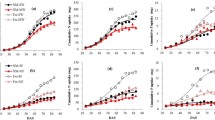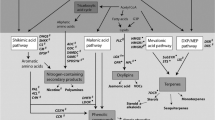Abstract
Using recently developed solution culture techniques, the effect of a non-resource abiotic stress, nickel toxicity, was tested on intraspecific nutrient competition among wheat. The choice of an appropriate statistical model was of paramount importance in interpreting these effects. We argue that a multiplicative model is more appropriate for experiments on interactions of competition and abiotic stress. By such an analysis, nickel had no relative effect on the ability of competition to reduce plant size in two experiments, and caused a small reduction in competition in another. These results are contrary to other reports of the effect of a non-resource abiotic stress on competition and appear to be due to an increased demand for nutrients in the presence of toxic levels of nickel. The effects of an abiotic stress on competition may thus be specitic to the stress and not generalized across all abiotic stresses.
Similar content being viewed by others
References
Aerts R, Berendse F, Caluwe H de, Schmitz M (1990) Competition along an experimental gradient of nutrient availability. Oikos 57: 301–318
Aerts R, Boot RGA, Aart PJM van der (1991) The relation between above- and belowground biomass allocation patterns and competitive ability. Oecologia 87: 551–559
Campbell BD, Grime JP (1992) An experimental test of plant strategy theory. Ecology 73: 15–29
Christensen ER, Chen CY (1985) A general noninteractive multiple toxicity model including probit, logit, and Weibull transformations. Biometrics 41: 711–725
Christensen ER, Scherfig J, Dixon PS (1979) Effects of manganese, copper and lead on Selenastrum capricornutum and Chlorella stigmatophora. Water Res 13: 79–92
Cornell JA, Berger RD (1987) Factors that influence the value of the coefficient of determination in simple linear and nonlinear regression models. Phytopathology 77: 63–70
Davis RD, Carlton-Smith CH (1984) An investigation into the phytotoxicity of zinc, copper and nickel using sewage sludge of controlled metal content. Environ Pollut Ser B 8: 163–185
Gause GF (1934) The struggle for existence. Williams and Wilkins, Baltimore
Grace JB (1990) On the relationship between plant traits and competitive ability. In: Grace JB, Tilman D (eds) Perspectives on plant competition. Academic Press, San Diego, pp 51–65
Grace JB, Tilman D (1990) Perspectives on plant competition: some introductory remarks In: Grace JB, Tilman D (eds) Perspectives on plant competition. Academic Press, San Diego, pp 3–7
Grime JP (1977) Evidence for the existence of three primary strategies in plants and its relevance to ecological and evolutionary theory. Am Nat 111: 1169–1194
Hutchinson TC (1981) Nickel. In: Lepp NW (ed) Effects of heavy metal pollution on plants, vol 1, Effects of trace metals on plant function. Applied Science Publishers, London, UK, pp 171–211
Ingestad T (1982) Relative addition rate and external concentration: driving variables used in plant nutrition research. Plant Cell Environ 5: 443–453
Ingestad T, Lund AB (1979) Nitrogen stress in birch seedlings I: Growth technique and growth. Physiol Plant 45: 137–148
Johnson WR, Proctor J (1981) Growth of serpentine and nonscrpentine races of Festuca rubra in solutions simulating the chemical conditions in a toxic serpentine soil. J Ecol 69: 855–869
Lockhart JA (1965) The analysis of interactions of physical and chemical factors on plant growth. Annu Rev Plant Physiol 16: 37–52
McCarthy PC, Schroeder ED (1973) Discussion on: F de Villaret and DM Himmelblau, “Kinetic modeling of aeration basins”. J Water Pollut Control Fed 45: 1635
Morris EC, Myerscough PJ (1991) Self-thinning and competition intensity over a gradient of nutrient availability. J Ecol 79: 903–923
Novozamsky I, Eck R van, Shouwenburg J Ch van, Walinga I (1974) Total nitrogen determination by means of the indophenol blue method. Neth J Agric Sci 22: 3–5
Prepas EE, Rigler FH (1982) Improvements in quantifying the phosphorus concentration in lake water. Can J Fish Aquat Sci 39: 822–829
SAS Institute (1991) SAS users guide: statistics, version 6 edn. SAS Institute, Cary
Sherwood RTB, Risser PG (1979) Dispersion and co-dispersion in Oklahoma upland forests. Bull Torrey Bot Club 106: 200–204
Sokal RR Rohlf FJ (1981) Biometry, 2nd edn. Freeman, New York
Stadt KJ (1992) A physiological study of the effects of an abiotic stress on competition. M.Sc. thesis, University of Alberta, Canada
Stadt KJ, Taylor GJ, Dale MRT (1992) Control of relative growth rate by application of the relative addition rate technique to a traditional solution culture system. Plant Soil 142: 119–122
Taylor GJ (1989) Multiple metal stress in Triticum aestivum L. Differentiation between additive, antagonistic, and synergistic effects. Can J Bot 67: 2272–2276
Taylor GJ, Stadt KJ, Dale MRT (1992) Modeling the interactive effects of aluminum, cadmium, manganese nickel, and zinc stress using the Weibull frequency distribution. Environ Exp Bot 32: 281–293
Thompson K (1987) The resource ratio hypothesis and the meaning of competition. Funct Ecol 1: 297–315
Thompson K, Grime JP (1988) Competition reconsidered — a reply to Tilman. Funct Ecol 2: 114–116
Tilman D (1988) Plant strategies and the dynamics and structure of plant communities. Princeton University Press, Princeton
Villaret F de, Himmelblau DM (1973) Kinetic modeling of aeration basins. J Water Pollut Control Fed 45: 292–303
Welden CW, Slauson WL (1986) The intensity of competition versus its importance: an overlooked distinction and some implications. Q Rev Biol 61: 23–43
Wiens JA (1977) On competition and variable environments. Am Sci 65: 590–597
Wilson JB (1988) Shoot competition and root competition. J Appl Ecol 25: 279–296
Wilson SD, Tilman D (1993) Plant competition and resource availability in response to disturbance and fertilization. Ecology 74: 599–611
Zar JH (1984) Biostatistical analysis. Prentice-Hall, Englewood Cliffs
Author information
Authors and Affiliations
Rights and permissions
About this article
Cite this article
Stadt, K.J., Taylor, G.J. & Dale, M.R.T. Measuring the effect of an abiotic stress on competition. Oecologia 100, 221–228 (1994). https://doi.org/10.1007/BF00316948
Received:
Accepted:
Issue Date:
DOI: https://doi.org/10.1007/BF00316948




